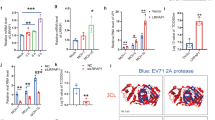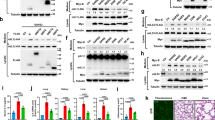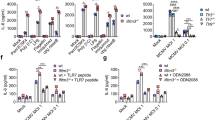Abstract
Interferon-α (IFN-α) is essential for antiviral immunity, but in the absence of matrix metalloproteinase-12 (MMP-12) or IκBα (encoded by NFKBIA) we show that IFN-α is retained in the cytosol of virus-infected cells and is not secreted. Our findings suggest that activated IκBα mediates the export of IFN-α from virus-infected cells and that the inability of cells in Mmp12−/− but not wild-type mice to express IκBα and thus export IFN-α makes coxsackievirus type B3 infection lethal and renders respiratory syncytial virus more pathogenic. We show here that after macrophage secretion, MMP-12 is transported into virus-infected cells. In HeLa cells MMP-12 is also translocated to the nucleus, where it binds to the NFKBIA promoter, driving transcription. We also identified dual-regulated substrates that are repressed both by MMP-12 binding to the substrate's gene exons and by MMP-12–mediated cleavage of the substrate protein itself. Whereas intracellular MMP-12 mediates NFKBIA transcription, leading to IFN-α secretion and host protection, extracellular MMP-12 cleaves off the IFN-α receptor 2 binding site of systemic IFN-α, preventing an unchecked immune response. Consistent with an unexpected role for MMP-12 in clearing systemic IFN-α, treatment of coxsackievirus type B3–infected wild-type mice with a membrane-impermeable MMP-12 inhibitor elevates systemic IFN-α levels and reduces viral replication in pancreas while sparing intracellular MMP-12. These findings suggest that inhibiting extracellular MMP-12 could be a new avenue for the development of antiviral treatments.
This is a preview of subscription content, access via your institution
Access options
Subscribe to this journal
Receive 12 print issues and online access
$209.00 per year
only $17.42 per issue
Buy this article
- Purchase on SpringerLink
- Instant access to full article PDF
Prices may be subject to local taxes which are calculated during checkout






Similar content being viewed by others
References
Wang, B.X. & Fish, E.N. The yin and yang of viruses and interferons. Trends Immunol. 33, 190–197 (2012).
Brunner, K.T., Hurez, D., Mc, C.R. & Benacerraf, B. Blood clearance of P32-labeled vesicular stomatitis and Newcastle disease viruses by the reticuloendothelial system in mice. J. Immunol. 85, 99–105 (1960).
Shapiro, S.D., Kobayashi, D.K. & Ley, T.J. Cloning and characterization of a unique elastolytic metalloproteinase produced by human alveolar macrophages. J. Biol. Chem. 268, 23824–23829 (1993).
Belvisi, M.G. & Bottomley, K.M. The role of matrix metalloproteinases (MMPs) in the pathophysiology of chronic obstructive pulmonary disease (COPD): a therapeutic role for inhibitors of MMPs? Inflamm. Res. 52, 95–100 (2003).
Liang, J. et al. Macrophage metalloelastase accelerates the progression of atherosclerosis in transgenic rabbits. Circulation 113, 1993–2001 (2006).
Curci, J.A., Liao, S., Huffman, M.D., Shapiro, S.D. & Thompson, R.W. Expression and localization of macrophage elastase (matrix metalloproteinase-12) in abdominal aortic aneurysms. J. Clin. Invest. 102, 1900–1910 (1998).
McQuibban, G.A. et al. Inflammation dampened by gelatinase A cleavage of monocyte chemoattractant protein-3. Science 289, 1202–1206 (2000).
Parks, W.C., Wilson, C.L. & Lopez-Boado, Y.S. Matrix metalloproteinases as modulators of inflammation and innate immunity. Nat. Rev. Immunol. 4, 617–629 (2004).
Morrison, C.J., Butler, G.S., Rodriguez, D. & Overall, C.M. Matrix metalloproteinase proteomics: substrates, targets, and therapy. Curr. Opin. Cell Biol. 21, 645–653 (2009).
Houghton, A.M. et al. Macrophage elastase (matrix metalloproteinase-12) suppresses growth of lung metastases. Cancer Res. 66, 6149–6155 (2006).
Dean, R.A. et al. Macrophage-specific metalloelastase (MMP-12) truncates and inactivates ELR+ CXC chemokines and generates CCL2, -7, -8, and -13 antagonists: potential role of the macrophage in terminating polymorphonuclear leukocyte influx. Blood 112, 3455–3464 (2008).
Houghton, A.M., Hartzell, W.O., Robbins, C.S., Gomis-Ruth, F.X. & Shapiro, S.D. Macrophage elastase kills bacteria within murine macrophages. Nature 460, 637–641 (2009).
Lambert, A.L., Mangum, J.B., DeLorme, M.P. & Everitt, J.I. Ultrafine carbon black particles enhance respiratory syncytial virus–induced airway reactivity, pulmonary inflammation, and chemokine expression. Toxicol. Sci. 72, 339–346 (2003).
Samuel, C.E. Antiviral actions of interferons. Clinical Microbiol. Rev. 14, 778–809 (2001).
Guerrero-Plata, A., Casola, A. & Garofalo, R.P. Human metapneumovirus induces a profile of lung cytokines distinct from that of respiratory syncytial virus. J. Virol. 79, 14992–14997 (2005).
Vallabhapurapu, S. & Karin, M. Regulation and function of NF-κB transcription factors in the immune system. Annu. Rev. Immunol. 27, 693–733 (2009).
Garmaroudi, F.S. et al. Pairwise network mechanisms in the host signaling response to coxsackievirus B3 infection. Proc. Natl. Acad. Sci. USA 107, 17053–17058 (2010).
Shimizu-Hirota, R. et al. MT1-MMP- regulates the PI3Kδ.Mi-2/NuRD–dependent control of macrophage immune function. Genes Dev. 26, 395–413 (2012).
Wang, X. et al. Matrix metalloproteinase-7 and ADAM-12 (a disintegrin and metalloproteinase-12) define a signaling axis in agonist-induced hypertension and cardiac hypertrophy. Circulation 119, 2480–2489 (2009).
Mosser, D.M. & Edwards, J.P. Exploring the full spectrum of macrophage activation. Nat. Rev. Immunol. 8, 958–969 (2008).
Kleifeld, O. et al. Isotopic labeling of terminal amines in complex samples identifies protein N-termini and protease cleavage products. Nat. Biotechnol. 28, 281–288 (2010).
Koyanagi, S., Ohdo, S., Yukawa, E. & Higuchi, S. Chronopharmacological study of interferon-alpha in mice. J. Pharmacol. Exp. Ther. 283, 259–264 (1997).
Butler, G.S. & Overall, C.M. Proteomic identification of multitasking proteins in unexpected locations complicates drug targeting. Nat. Rev. Drug Discov. 8, 935–948 (2009).
Dufour, A. & Overall, C.M. Missing the target: matrix metalloproteinase antitargets in inflammation and cancer. Trends Pharmacol. Sci. 34, 233–242 (2013).
Overall, C.M. & Kleifeld, O. Tumour microenvironment—opinion: validating matrix metalloproteinases as drug targets and anti-targets for cancer therapy. Nat. Rev. Cancer 6, 227–239 (2006).
Devel, L. et al. Development of selective inhibitors and substrate of matrix metalloproteinase-12. J. Biol. Chem. 281, 11152–11160 (2006).
Johnson, J.L. et al. A selective matrix metalloproteinase-12 inhibitor retards atherosclerotic plaque development in apolipoprotein E–knockout mice. Arterioscler. Thromb. Vasc. Biol. 31, 528–535 (2011).
Rizza, P., Moretti, F. & Belardelli, F. Recent advances on the immunomodulatory effects of IFN-α: implications for cancer immunotherapy and autoimmunity. Autoimmunity 43, 204–209 (2010).
Cheung, C. et al. Ablation of matrix metalloproteinase-9 increases severity of viral myocarditis in mice. Circulation 117, 1574–1582 (2008).
Starr, A.E. & Overall, C.M. Chapter 13. Characterizing proteolytic processing of chemokines by mass spectrometry, biochemistry, neo-epitope antibodies and functional assays. Methods Enzymol. 461, 281–307 (2009).
Buroker, N.E., Barboza, J. & Huang, J.Y. The IκBα gene is a peroxisome proliferator–activated receptor cardiac target gene. FEBS J. 276, 3247–3255 (2009).
Kleifeld, O. et al. Identifying and quantifying proteolytic events and the natural N terminome by terminal amine isotopic labeling of substrates. Nat. Protoc. 6, 1578–1611 (2011).
Robertson, G. et al. Genome-wide profiles of STAT1 DNA association using chromatin immunoprecipitation and massively parallel sequencing. Nat. Methods 4, 651–657 (2007).
auf dem Keller, U., Prudova, A., Gioia, M., Butler, G.S. & Overall, C.M. A statistics-based platform for quantitative N-terminome analysis and identification of protease cleavage products. Mol. Cell. Proteomics 9, 912–927 (2010).
Prudova, A., auf dem Keller, U., Butler, G.S. & Overall, C.M. Multiplex N-terminome analysis of MMP-2 and MMP-9 substrate degradomes by iTRAQ-TAILS quantitative proteomics. Mol. Cell. Proteomics 9, 894–911 (2010).
Fahlman, R.P., Chen, W. & Overall, C.M. Absolute proteomic quantification of the activity state of proteases and proteolytic cleavages using proteolytic signature peptides and isobaric tags. J. Proteomics 100, 79–91 (2014).
Pedrioli, P.G. Trans-proteomic pipeline: a pipeline for proteomic analysis. Methods Mol. Biol. 604, 213–238 (2010).
Deutsch, E.W. et al. A guided tour of the Trans-Proteomic Pipeline. Proteomics 10, 1150–1159 (2010).
Keller, A., Nesvizhskii, A.I., Kolker, E. & Aebersold, R. Empirical statistical model to estimate the accuracy of peptide identifications made by MS/MS and database search. Anal. Chem. 74, 5383–5392 (2002).
auf dem Keller, U. & Overall, C.M. An add-on to the Trans-Proteomic Pipeline for the Automated Analysis of TAILS data. Biol. Chem. 393, 1477–1483 (2012).
Acknowledgements
We thank C. Smits at St. Paul's Hospital for technical assistance and expert advice regarding the humane care of animal models used in this study. We thank T. Buroker at Seattle Children's Hospital for IκBα plasmid promoter constructs and A. Hoffmann at the University of California–San Diego for Nfkbia−/− cells and advice. HL1 cardiomyocytes were a gift from W. Claycomb (Louisiana State University). This work was supported by Canadian Institutes of Health Research grants on MMPs during viral infection (no. 08-0369 (B.M.M., D.J.M.)) and on MMPs in inflammation (nos. MOP-37937 and MOP-111055 (C.M.O.)) and an Infrastructure Grant from the Michael Smith Research Foundation (University of British Columbia Centre for Blood Research) and by the British Columbia Proteomics Network (C.M.O.); salary support for D.J.M. is provided by a Canada Research Chair in Viral Pathogenesis and is supported by research fellowships from the US Myocarditis Foundation and the Heart and Stroke Foundation of Canada; H.L. is funded by the Heart and Stroke Foundation of British Columbia and Yukon; salary support for C.M.O. is provided by a Canada Research Chair in Metalloproteinase Proteomics and Systems Biology B.M.M. is funded by the Heart and Stroke Foundation of British Columbia and Yukon, Genome Canada/British Columbia and the Networks of Centres of Excellence–CECR Centre of Excellence for Prevention of Organ Failure.
Author information
Authors and Affiliations
Contributions
D.J.M. conceived of, performed and planned most experiments, analyzed the data and wrote the paper. C.L.B. performed TAILS, analyzed proteomic data, performed biochemical cleavage assays and expressed and purified MMP-12; T.J.M. planned and conducted the respiratory syncytial virus in vivo experiments in Figure 1 and supplementary information; S.J.W. provided guidance on MMP biology and the direction of the project; A.D. performed western blotting, mass spectrometry/biochemical analyses of IFN-α cleavage assays and biochemical validation of the MMP-12 inhibitor RXP470.1 on MMP-s in vitro and in vivo; G.S.B. expressed and purified MMP-2, MMP-8 and MMP-14, edited the paper and did IFN-α digestion assays; L.M.B. performed macrophage coculture experiments, ran western blots, did ELISA for cytokines, did RNAi for IκBα and performed confocal microscopy for IFN-α and MMP-12. R.G.H. performed macrophage coculture experiments and ran western blots; A.G.R. analyzed ChIP-PCR and ChIP-Seq data and identified MMP-12 target genes; C.T.C. performed the first Mmp12−/− in vivo experiment; J.N. performed ELISAs, confocal microscopy and experiments on human biopsy samples; L.A. performed surgeries and RXP470.1 in vivo treatment experiments; Z.L. performed western blots, ELISAs, in situ hybridization for virus and immunohistochemistry and analyzed data; K.H. performed ChIP-PCR; M.J.N. performed in vivo respiratory syncytial virus experiments in Figure 1 and supplementary information ; W.D. performed in vivo respiratory syncytial virus experiments in Figure 1 and supplementary information; T.B. performed ELISAs and edited the paper; A.K. performed ChIP-PCR and western blots; L.D. and D.G. designed and synthesized RXP470.1; R.G.H. conceived of experiments and edited the manuscript; H.L. provided crucial advice and guidance regarding the cell culture and cell biology experiments and the mouse experiments; D.J.G. performed surgeries and RXP470.1 in vivo treatment experiments; V.D. designed and synthesized RXP470.1; B.M.M. conceived of the in vivo experiments, analyzed data, conducted histopathological analysis and supervised the project; C.M.O. conceived of in vivo and in vitro experiments, designed proteomics analyses, wrote and edited the paper, analyzed data and supervised and provided support for the project.
Corresponding authors
Ethics declarations
Competing interests
The authors declare no competing financial interests.
Supplementary information
Supplementary Text and Figures
Supplementary Figures 1–10 and Supplementary Table 1 (PDF 15658 kb)
Supplementary Tables
Supplementary Tables 2–4 (PDF 3798 kb)
Rights and permissions
About this article
Cite this article
Marchant, D., Bellac, C., Moraes, T. et al. A new transcriptional role for matrix metalloproteinase-12 in antiviral immunity. Nat Med 20, 493–502 (2014). https://doi.org/10.1038/nm.3508
Received:
Accepted:
Published:
Issue Date:
DOI: https://doi.org/10.1038/nm.3508
This article is cited by
-
Regulating metalloimmunology with nanomedicine for cancer therapy
Nano Research (2023)
-
Genetic deletion of MMP12 ameliorates cardiometabolic disease by improving insulin sensitivity, systemic inflammation, and atherosclerotic features in mice
Cardiovascular Diabetology (2023)
-
Heterogeneity, inherent and acquired drug resistance in patient-derived organoid models of primary liver cancer
Cellular Oncology (2022)
-
LPS aggravates lung inflammation induced by RSV by promoting the ERK-MMP-12 signaling pathway in mice
Respiratory Research (2020)
-
TIMP-3 facilitates binding of target metalloproteinases to the endocytic receptor LRP-1 and promotes scavenging of MMP-1
Scientific Reports (2020)



